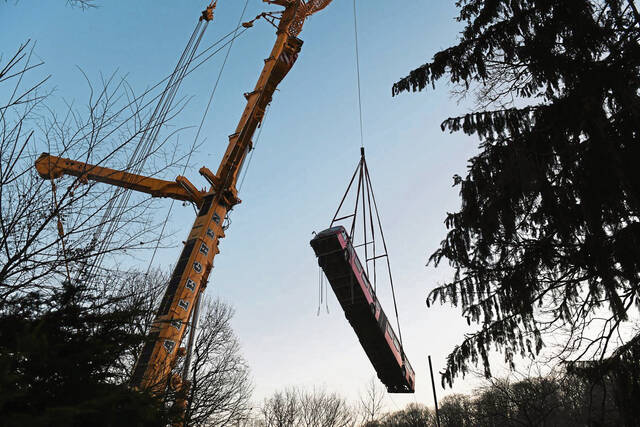https://triblive.com/local/ntsb-releases-fern-hollow-bridge-data-still-no-cause-of-collapse/
NTSB releases new Fern Hollow Bridge data; still no cause of collapse

Federal investigators on Thursday released more than 2,000 pages of records they have examined as part of their investigation into the collapse of Pittsburgh’s Fern Hollow Bridge nearly a year ago, but many critical details, such as the cause of the catastrophic failure, remain undisclosed.
The update, which includes only factual information without analysis, is the first since May by the National Transportation Safety Board, which behind the scenes has been conducting a comprehensive review of the design, construction, maintenance and repair history of the nearly 50-year-old span that collapsed Jan. 28.
“We are going to put this bridge under a microscope,” Jennifer Homendy, the NTSB’s chair, said during a visit to Pittsburgh at the time.
Among the records released are weather data, 1970s-era purchase orders and technical reports on testing of the steel used in the bridge construction, original construction plans, milling and paving project records and 1,291 pages of PennDOT manuals, which make up the bulk of the data dump.
Sometimes the board will release interview transcripts and police reports. It has not done so in this case, but could in the future.
Fern Hollow Bridge collapse• The lives of a group of strangers intersected on a snowy Pittsburgh morning when the Fern Hollow Bridge collapsed • Biden tours Fern Hollow Bridge work, touts infrastructure plans at Pittsburgh stop
The safety board said it has performed three-dimensional scans of portions of the bridge, tested fragments from the site, conducted interviews and examined 10 similar bridges in Pennsylvania.
The board said it could take a year or more of painstaking analysis before it determines why the bridge fell down mere hours before President Joe Biden visited Pittsburgh to tout a $1.2 trillion infrastructure package.
Five vehicles, including a Port Authority bus, were on the 447-foot “K-frame” span over Frick Park when it broke apart before dawn on a snowy morning. The bus, two cars, an SUV and a pickup plummeted and tumbled into a ravine 100 feet below, injuring drivers and passengers.
A sixth vehicle drove off an abutment in the darkness and landed on its roof.
Investigators who reviewed footage from cameras on the Port Authority bus (now known as Pittsburgh Regional Transit) have previously said that the bridge broke apart around 6:40 a.m., starting at its west end.
The Fern Hollow Bridge had a long history of problems, reflected in its “poor” rating since 2011 and concerns raised by an inspection just a few months before the collapse.
Over the years, the maximum weight the span could carry was reduced to 26 tons, and the frequency of inspections was increased to each year as opposed to every other year.
Despite mounting and chronic evidence of significant corrosion and deterioration, inspectors did not consider the bridge to be in danger of imminent failure, and its owner, the City of Pittsburgh, never undertook steps to fix the span enough to improve its rating.
Federal investigators have said that while sections of the bridge’s welded steel girders were “fracture critical” – meaning a failure of those areas “would probably” cause part or all of the bridge to collapse – there were no “primary fractures.”
In its update, the NTSB said its engineers examined fractures on the bridge’s legs with a 3D scanner. Investigators are almost done with testing the weathering steel that made up the bridge and its legs.
The safety board defined weathering steel as a group of steel alloys that form a protective coating through exposure to weather, eliminating the need for painting.
The Fern Hollow Bridge, which opened in 1973 along Forbes Avenue after an earlier span was razed, carried roughly 14,000 vehicles a day and served as a vital link between Squirrel Hill and eastern neighborhoods.
Bridge collapses are rare in the United States, which has more than 600,000 spans. Pennsylvania’s more than 22,000 bridges have about twice as many in poor condition as the national average.
The collapse triggered a top-to-bottom review of Pittsburgh-owned bridges by the administration of Mayor Ed Gainey.
A new $25 million Fern Hollow Bridge opened in December ahead of schedule.
Copyright ©2025— Trib Total Media, LLC (TribLIVE.com)
